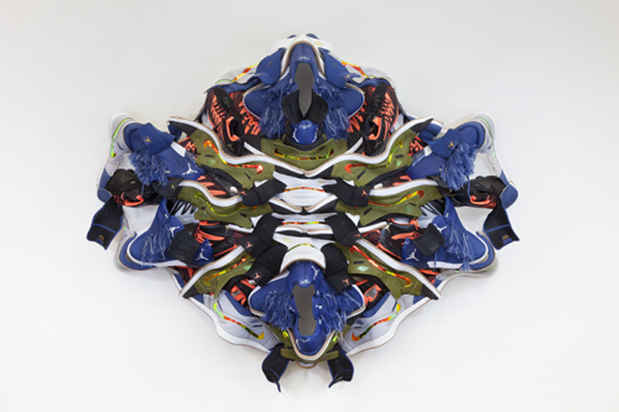Brian Jungen Exhibition
Casey Kaplan

[Image: Brian Jungen "Untitled" (2016) Nike Air Jordans, 80 x 60 x 12 in.]
This event has ended.
Casey Kaplan presents an exhibition of new sculptures by renowned artist, Brian Jungen. In 1998, while living in Vancouver the artist conceived his first sculptural works, “Prototype for New Understanding” (1998-2005). Converting Nike Air Jordan trainers into anthropological masks, using the traditional colors of black, white, red, integrated with human hair, Jungen made poignant references to contemporary assimilations and the commercial devaluing of revered customs and symbols. The process was an intimate one, as the shoes were laboriously altered by Jungen’s hand. Ultimately they were presented in a museum-like display as precious artifacts, with glass vitrines and supporting armatures. The Nike Air Jordan was a sought-after, pop-cultural symbol among Jungen’s adolescent peers in the Doig River band of the Dane-zaa First Nation and established Jungen’s interest in the reciprocal link between objects and people. In Jungen’s fourth exhibition at Casey Kaplan, he revisits this medium so instrumental to the beginnings of his practice. Jungen’s new sculptural objects, wall reliefs, and hanging curtain are made of cut, spliced and reformatted Air Jordan trainers transformed into abstracted compositions that generate broader interpretations.
Since his last show in the gallery in 2011, Jungen has relocated his home and studio to a more remote location outside of Vancouver. While his earlier work laid the groundwork for a commentary on indigenous stereotypes and notions of dual heritage, his more recent and continued experiences with his native culture prompted a palpable structural and material transformation in his practice. With his more frequent returns to Northern B.C. in recent years, Jungen learned the traditional techniques of his First Nations people, including animal hide crafts and drum making. He also resumed skills cultivated while growing up on his family’s farm among the Doig River community, such as hunting and horseback riding. (As an avid horseman, some of the mask-like works presented in this exhibition were tailored specifically for one of his horses.) Untying himself from a refined treatment of resources, while maintaining his own presence with hand-sewing and carving, the works presented are liberated in an honest portrayal of material metamorphosis which is in direct engagement with the artist’s lifestyle. Residing now on his ranch, his process includes the use of varying shop tools such as industrial sewing machines (originally used for horse saddles) and bandsaws (operated daily on the ranch). Jungen uses only preexisting hardware in an attempt to minimize the visibility of extraneous materials and display devices. Incorporating all of the components of the shoes in an increasingly autonomous approach to modernist composition, the consumable, wearable objects have self-generated as sculpture.
The components of the shoes independently support and embrace the renewed structures. Viewed in the round, the freestanding sculptures offer insight into Jungen’s technique of cutting through stacked and compressed rubber soles, for each layer of synthetic fabric, leather and rubber is exposed. To access the exhibition one must enter through a veil of fluorescent shoelaces, seamed onto insoles suspended from the ceiling. Conscious of using the whole shoe, the curtain walks us through time by incorporating remnants of soles left over from the first “Prototype for New Understanding” series. In wall reliefs, the artist taps into an anthropomorphic realm between the alien and familiar with unraveled and tufted shoelaces, indicative of the use of human hair in previous work. In many respects, the resulting formation simulates the futuristic design of the Air Jordan as it exists in today’s market.
In the past, and specifically for those hailing from Jungen’s hometown, the limited editions of the Nike Air Jordans were practically unattainable. With Nike’s new mass-market approach and broadened international scope in recent years, not to mention the increased accessibility of the Internet, the trainers have become a ubiquitous commodity. Iconic still, their cultural and luxury implications have changed over time. Jungen has altered his treatment and handling of the material to reflect this new understanding and as the result, his newest sculptures can no longer be labeled as prototypes.
Brian Jungen (b. 1970, Fort St. John, B.C.) lives and works in North Okanagan, B.C. The artist has presented solo exhibitions at venues such as Hannover Kunstverein (2013); Bonner Kunstverein (2013); Art Gallery of Alberta, Edmonton (2011); Art Gallery of Ontario, Toronto (2011); The Smithsonian National Museum of the American Indian, Washington, DC (2009); Museum Villa Stuck, Münich (2008); Witte de With, Rotterdam (2007); Tate Modern, London (2006); Vancouver Art Gallery (2006); Musée d’art Contemporain de Montréal (2006); New Museum, New York (2005); and CCA Wattis Institute for Contemporary Arts, San Francisco (2004). With recent group exhibitions at venues such as the Rennie Collection, Vancouver (2016) and Vancouver Art Gallery (2016), the artist is scheduled to present a solo exhibition at the University of New Mexico Art Museum, Albuquerque in 2018. Jungen is included in the permanent collections of the AGO, Toronto; Hirshhorn Museum and Sculpture Garden, Washington, D.C.; Museum of Contemporary Art, Chicago; National Gallery of Canada, Ottawa; Seattle Museum of Art; The Smithsonian National Museum of the American Indian, Washington, D.C.; Tate Modern, London; and Vancouver Art Gallery, B.C.
Media
Schedule
from June 24, 2016 to July 29, 2016
Opening Reception on 2016-06-24 from 18:00 to 20:00